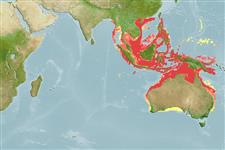Issue
Distribution needs major revision due to questionable (unconfirmed) occurences reported by major references (Ref. 57869:385-6).
Environment: milieu / climate zone / depth range / distribution range
экология
морской ассоциированный с рифами; амфидромный (Ref. 51243); пределы глубины 1 - 350 m (Ref. 38189). Subtropical; 45°N - 44°S, 89°E - 154°E
Eastern Indian Ocean, Malay Peninsula, southern Philippines, northern Java, Arafura Sea, Louisiade Archipelago, and northern half and southwestern Australia. Reports of Introduction in the Mediterranean are questionable. Confirmed and questionable reports of its occurrence (and references) are discussed in Inoue & Nakabo 2006 (Ref. 57869:385-6).
Length at first maturity / Size / Вес / Возраст
Maturity: Lm 19.8 range ? - ? cm
Max length : 50.0 cm SL самец/пол неопределен; (Ref. 3397); common length : 30.0 cm TL самец/пол неопределен; (Ref. 5450); наибольший возраст (опубликованны данные): 7 годы (Ref. 94612)
колючие лучи спинного плавника (общее число) : 0; членистые (мягкие) лучи спинного плавника (общее число) : 11 - 12; колючие лучи анального плавника: 0; членистые (мягкие) лучи анального плавника: 11 - 12. Cigar-shaped, rounded or slightly compressed; the head pointed and depressed; the snout rounded. Dorsal origin closer to the adipose origin than the snout tip. Anal fin origin is closer to the tail base than the operculum. Color is brown-gray above and creamy below, with 8-10 indistinct darker spots along the middle of the sides.
Found on the sublittoral zone above 100 m over sand or mud bottoms of coastal waters (Ref. 11228, 11230). Feeds on fishes (anchovy and red mullet Mullus surmuletus), crustaceans, and other invertebrates (Ref. 5213). Spawns from April to May off Japan. Generally marketed frozen, sometimes fresh and as fish cakes ('kamaboko') in Japan (Ref. 4964). Minimum depth from Ref. 12260.
Russell, B.C., 1999. Synodontidae: lizardfishes (also bombay ducks, sauries). p. 1928-1945. In K.E. Carpenter and V.H. Niem (eds.) FAO species identification guide for fishery purposes. The living marine resources of the Western Central Pacific. Vol. 3. Batoid fishes, chimaeras and bony fishes. Part 1 (Elopidae to Linophrynidae). FAO, Rome. pp. 1397-2068. (Ref. 38189)
Статус Красного Списка МСОП (Ref. 130435: Version 2024-1)
Угроза для людей
Harmless
Использование человеком
рыболовство: не имеет хозяйственного значения
дополнительная информация
инструменты
Специальные отчеты
Скачать в формате XML
ресурсы в Интернет
Estimates based on models
Preferred temperature (Ref.
123201): 18.8 - 27.9, mean 26 °C (based on 583 cells).
Phylogenetic diversity index (Ref.
82804): PD
50 = 0.5000 [Uniqueness, from 0.5 = low to 2.0 = high].
Bayesian length-weight: a=0.00550 (0.00478 - 0.00632), b=3.10 (3.06 - 3.14), in cm total length, based on LWR estimates for this species (Ref.
93245).
Trophic level (Ref.
69278): 4.5 ±0.4 se; based on diet studies.
Generation time: 2.7 (1.8 - 3.5) years. Estimated as median ln(3)/K based on 40
growth studies.
устойчивость к внешним воздействиям (Ref.
120179): средний (среднего размера), минимальное время удвоения популяции 1.4-4.4 года (K=0.3-0.9; tm=1-2; tmax=8; Fec=84,802).
Fishing Vulnerability (Ref.
59153): Moderate vulnerability (39 of 100).
Climate Vulnerability (Ref.
125649): Low vulnerability (25 of 100).
Nutrients (Ref.
124155): Calcium = 20.3 [6.4, 45.4] mg/100g; Iron = 0.406 [0.138, 0.948] mg/100g; Protein = 16 [14, 19] %; Omega3 = 0.105 [0.035, 0.259] g/100g; Selenium = 22.4 [8.0, 51.5] μg/100g; VitaminA = 63.6 [15.2, 235.3] μg/100g; Zinc = 0.508 [0.287, 0.826] mg/100g (wet weight); based on
nutrient studies.
